Running multiple versions of the Framework in ASP.NET
Microsoft has done a great job of allowing multiple versions of the framework to run side by side. Version v1.0, v1.1 and v2.0 can all run together at the same time on the same server. Each site, or even a vdir (Virtual Directory) within a site can have its own version of the framework installed. Simply install the framework version on your server and it will be available to you. The install itself is quite small, for example the v2.0 download is 22MB.
The Microsoft homepage for the .NET Framework is:
http://msdn.microsoft.com/netframework/downloads/updates/default.aspx
There are a couple gotchas to consider with running multiple versions of the framework side by side. First, let's dig into IIS a bit. Following is a snapshot of Windows Task Manager on an IIS5 (Windows 2000) server:

Notice the 3 processes called aspnet_wp.exe. There is one per version of the framework. (v1.0, v1.1 and v2.0) If a process for a particular version of the framework doesn't exist, as soon as it's needed, a new process will be spun up. This allows multiple versions of the framework to live beside each other in IIS5. No effort, no pain . . . it just works.
Now consider the following IIS6 (Windows Server 2003) screenshot:

Notice that there aren't any aspnet_wp.exe processes anymore, but there are w3wp.exe processes instead. IIS6 was an impressive upgrade that brought with it some new concepts. One key new concept is Application Pools. A system administrator is able to create groups of sites and place each site in its own group. Whenever a site needs to run, a w3wp.exe process will start for its application pool if it hasn't already started. This brings with it a number of welcome security, performance and management advantages. You are now able to specify your own Identity User which can be unique per Application Pool.
In IIS6, the aspnet_wp.exe process is done away with, and the work that it did is now done within each w3wp.exe process. This has the same advantages I mentioned previously, but it has one big gotcha!
You cannot run more than one version of the framework in the same application pool in IIS6.
While multiple versions of the framework can co-exist on the same server, they can't co-exist in the same process. If you attempt to run multiple versions of the framework at the same time in the same process, the 2nd version that tries to run will fail with the following error:
Server Application Unavailable
The web application you are attempting to access on this web server is currently unavailable. Please hit the "Refresh" button in your web browser to retry your request.
Administrator Note: An error message detailing the cause of this specific request failure can be found in the application event log of the web server. Please review this log entry to discover what caused this error to occur.
"It is not possible to run two different versions of ASP.NET in the same IIS process. Please use the IIS Administration Tool to reconfigure your server to run the application in a separate process."
What to do
Fortunately, the solution is easy enough. Simply create a new application pool and move the site that you will be upgrading to that pool. You can even base it off of the existing one if you don't have the password memorized for the existing one. This is all done within IIS. Once you have placed the site or vdir in its own application pool, then you are ready to upgrade to the new framework version.
I'll cover the different ways to move between different versions of the framework in another blog within the next few days, but the key thing to walk away with now is that multiple versions of the framework cannot co-exist in the same worker process at the same time. IIS5 didn't have any issue with this, but IIS6 requires that each version be in its own app pool.